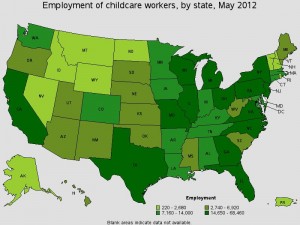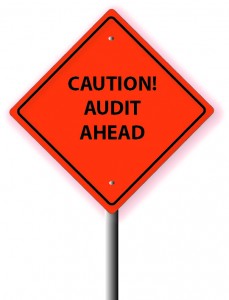ORGANIZING YOUR CHILD CARE BUSINESS RECORDS FOR SUCCESS!
 More than half of my clients are child care providers, and many of them became clients after attending one of my tax and record keeping seminars to the child care community through YMCA Child Resource Services. According to a recent report, the Bureau of Labor claims that one-third of all child care providers operate as self-employed businesses, and many of these child care providers care for children in their home.
More than half of my clients are child care providers, and many of them became clients after attending one of my tax and record keeping seminars to the child care community through YMCA Child Resource Services. According to a recent report, the Bureau of Labor claims that one-third of all child care providers operate as self-employed businesses, and many of these child care providers care for children in their home.
 Did you know that child care providers are 2.5 times more likely to be audited than non-self-employed filers?
Did you know that child care providers are 2.5 times more likely to be audited than non-self-employed filers?
In the 17 years I have been giving this 3-hour seminar, a good portion covers practices and guidelines to help child care providers improve their record keeping so if they are audited, their records will stand up to scrutiny.
Maybe someone reading this is thinking about doing their own taxes using one of the tax software programs out there. Do yourself a favor, before you submit have your information reviewed by a professional tax preparer who is a specialist in preparing child care provider taxes. The tax code is changing constantly. We monitor IRS and financial market information every day. If you are considering using a wholesale tax preparation service, you run a risk that the person sitting across the desk from you may not know anything about the child care business, or the deductions that can be claimed specifically for you. They may not know specific questions to ask that could increase your return potential. My clients have told me that selection of a tax preparer is as important as selecting a dentist or a doctor to them.
In our “selecting a tax preparer” we go over the kind of things you might want to know about your tax preparer. Please don’t shop by price. Going cheap might end up costing you money – or worse – an audit.
The following are simple guidelines for record keeping. We also provide checklists and guidelines in our Resource section. Please feel free to download and use them. I also would encourage you to contact me if you have any uncertainty about your past tax filings, or your current business condition. You can reach me at 619-589-8680.
Related Reading: Tax & Recordkeeping Seminar Guidebook. The Child Care Tax Center,

What should you do first?
The best way to ensure you are keeping the right records, in the right way, is to meet with your tax preparer, however, if you decide to DIY, then please refer to the IRS Child Care Tax Center, select tax forms and information booklets you will need, go to your state tax office for their specific tax forms, read the instruction pages carefully to determine the appropriate filing status and forms required for your child care business. If you are shopping for a tax preparer – I recommend getting a tax preparer who understands your child care business. Do not shop by price. Read testimonials. Get references. Talk to other child care providers.
Establishing what kind of “business” you are.
A sole proprietorship forms report taxes for an unincorporated business you operate yourself. If you operate the daycare with another person, or a group of people, and all contribute to the business, you might file as a partnership. Each partner pays taxes on the profits or losses based on the partner’s interest in the daycare when filing as a partnership.
Daycare operations organized under corporation laws, including C and S corporations, typically take the same tax deductions as a daycare operating as a sole proprietorship, but your daycare must also file special federal corporate tax forms. The IRS website and filing information booklets itemize the required tax forms for the various types of corporations.
A daycare organized as a Limited Liability Company (LLC), recognized in some states, must file as a partnership, corporation or sole proprietorship for federal tax filing. The Internal Revenue Service doesn’t recognize the LLC business organization for filing federal taxes. States recognizing LLC business arrangements offer information booklets or instruction forms to explain the state filing process.
What information do you need about your in-home business?
Collect receipts and statements that document the home mortgage amount due at the time the daycare operation started, the original price paid for the home and your payments for property tax, homeowner insurance and any mortgage insurance. If you rent, collect receipts for the total amount for the entire tax year.
How many feet do you use in your home for your business?
Measure the square footage of your home and calculate the amount from this figure that is used exclusively for daycare to calculate the tax deductions for mortgage interest, property taxes, building insurance or rent deductions for your business. Also measure the square footage of bathrooms used by staff and children, as well as the kitchen, if it was used for business food preparation. These areas may qualify for depreciation or tax deductions. The formula for calculating square footage is a=S2 (a = area and s = side) Example, to calculate the square footage of a room that is 15 feet wide and 12 long, you would multiply 15 x 12, which will give you the square footage.
What receipts do I need to keep? In short – everything.
Start a year with expandable (3″) folders. Label the folders, for example, books, arts & crafts materials, furniture, office equipment, cleaning services and/or products, etc. Make a photocopy of your receipts because sometimes they fade. Throughout the year, record any purchases of the items and equipment you purchased to operate your daycare. You file the receipts in the corresponding folder. This includes toys, computers and peripherals, playground equipment and supplies (basketballs, softballs, rackets, etc.), sleeping and play mats, storage containers, bookcases and child-sized furniture. All of these may qualify for full or partial tax deductions for your business.
What about joint-use receipts or activities?
Make a list of the Items purchased during the year and used jointly for the daycare business and for personal use and collect receipts for these items. These items qualify for a federal tax deduction based on the amount of time they were used for business. Calculate the amount of time each item is used in the daycare center. Keep this information as a record of each item for tax preparation.
What about training?
Collect bookkeeping information for any regular or part-time staff or assistants you paid to help with your home daycare, including salary and taxes paid on behalf of the employee to state and federal governments, as well as expenses paid for healthcare and benefits. Any training paid by the business to train staff for daycare operations may also qualify for federal deductions for the tax year.
What about receipts for food, beverages and other daily use materials.
Collect the receipts for items purchased for daily use in daycare operations during the year. Divide them into categories, including food served to the children during the day, office supplies and cleaning equipment and supplies. Use our Meal Plan template.
What about vehicle and mileage deductions?
Collect the receipts for gas, repair and maintenance and loan payment information for any vehicles used to operate the daycare. Assemble diary or calendar records to document the mileage total for the vehicles used to operate the daycare. Transportation to pick up and drop off daycare charges or travel to buy equipment or goods for the business may also qualify for tax deductions. Depending on your situation, you may depreciate your vehicle or use actual costs to document federal tax deductions for business-related travel.
What about receipts for my child care services?
Collect your records and business bank records documenting the amount paid to your daycare for services, including the daily fees charged for a child in your care and any transportation fees for picking up children and bringing the child to the daycare. Services also include any fees charged for snacks or meals. Using a separate income chart for each student helps keep your accounting records organized.
Some things you may want to use in setting up your records for the next year.
- 3″ colored expandable file folders
- Colored markers
- Plastic or cardboard boxes to hold files
- Standard File folders. Label according to tax categories and subjects
– Parent Paid Receipts
– Meal Log
– Mileage Log
– Daily Activities
Tips
- Use the expandable folders to hold the loose receipts (copies of receipts) in one place – per subject. Use the standard folders to hold reports, logs, correspondence, etc. Label these according to the federal tax categories and use them for rapid sorting or for organization and storage of folders for your daily receipts.
- If your home daycare business started during the year, your startup costs, including legal payments to draft incorporation, may qualify for federal tax deductions. Collect this paperwork and proof of payments for tax preparation.
- The receipt and document collection allows for tax preparation using a variety of accounting methods. It’s better to prepare for all possibilities rather than go back to locate the necessary documentation at tax time.
- Your local or regional IRS and state tax offices offer paper copies of tax forms and information booklets, and the websites for both agencies have digital files available for downloading to a computer.
Warning
- Mileage documentation is extremely important. Keep tight records of business and personal travel (use our simple mileage log in the resource center).
Resources: Daycare Tax Checklist, Simple mileage log
References
- ·IRS: Child Care Provider Audit Technique Guide
- ·Bureau of Labor Statistics: Child Care Workers
- ·SBA.gov: Small Business Expenses and Tax Deductions
- ·IRS: Publication 535 (2011) — Employees’ Pay
- ·IRS: Publication 535 (2011) — Rent Expense
- ·IRS: Publication 535 (2011) — Interest
- ·IRS: Publication 535 (2011) — Insurance
- ·IRS: Topic 509 — Business Use of Home
- ·IRS: Sole Proprietorships
- ·IRS: Partnerships
Additional Resources
- ·IRS: Publication 535 (2011) — Business Expenses
- ·SBA.gov: Fact Sheet — Tax Breaks for Small Businesses
- ·IRS: Publication 587 (2011) — Business Use or Your Home
- ·Penn State Better Kid Care Distance Education Lesson: Family Child Care — It’s a Business
- ·IRS: Starting a Business and Keeping Records
- ·IRS: Business Structures
- ·IRS: Limited Liability Company (LLC)
About R. Patrick Michael
For more than 30 years R. Patrick Michael has been preparing tax returns for individuals, small businesses, entrepreneurs and in-home child care providers. His wife operated a child care business for more than 25 years. Pat Michael is considered a child care tax expert.
Sources: The Houston Chronicle
Photo Credits : Bureau of Labor Statistics, RGS Business Solutions
